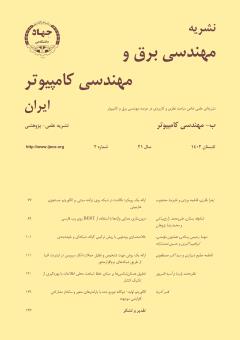الگوریتم اولیه- دوگانه توزیع شده با پارامترهای متغیر و ساختار مشارکتی افزایشی دوجهته
محورهای موضوعی : electrical and computer engineering
1 - دانشگاه صنعتی ارومیه
کلید واژه: الگوریتم پارامتر متغیر, بازسازی توزیعشده, حسگری فشرده, مد افزایشی دوجهته,
چکیده مقاله :
به دلیل شرایط خاص شبکههای حسگری بیسیم از نقطهنظرهایی نظیر محدودیت انرژی، تسریع سرعت همگرایی الگوریتمهای این حوزه اهمیت پیدا میکند. این امر در مورد حسگری فشرده توزیعشده که فاز بازسازی پیچیدهای دارد، ضروریتر به نظر میرسد. بر همین اساس در این مقاله، الگوریتم بازسازی حسگری فشرده توزیعشدهای ارائه میشود که امکان بازسازی با نرخ همگرایی بهبودیافتهتری را میسر میسازد. الگوریتم پیشنهادی، یک الگوریتم اولیه- دوگانه توزیعشده در یک ساختار افزایشی دوجهته است که در آن پارامترها با زمان تغییر میکنند. تغییرات پارامترها بهصورت ضابطهمند و برای آن دسته از مسائل بهینهسازی محدبی انجام میگیرد که در آنها توابعی که بیانکننده قید مسئله و مدلکننده مشارکت بین گرهها هستند، قویاً محدب میباشند. شیوه پیشنهادی با شبیهسازیهایی تضمین شده که نشان از عملکرد بالای الگوریتم پیشنهادی به لحاظ سرعت همگرایی، حتی در شرایط سختگیرانهتری نظیر تعداد اندک اندازهگیریها و یا درجه تنکی پایینتر دارد.
Special conditions of wireless sensor networks, such as energy limitation, make it essential to accelerate the convergence of algorithms in this field, especially in the distributed compressive sensing (DCS) scenarios, which have a complex reconstruction phase. This paper presents a DCS reconstruction algorithm that provides a higher convergence rate. The proposed algorithm is a distributed primal-dual algorithm in a bidirectional incremental cooperation mode where the parameters change with time. The parameters are changed systematically in the convex optimization problems in which the constraint and cooperation functions are strongly convex. The proposed method is supported by simulations, which show the higher performance of the proposed algorithm in terms of convergence rate, even in stricter conditions such as the small number of measurements or the lower degree of sparsity.
[1] ح. نظری، م. رئیسدانایی و م. سپهوند، "مکانیابی بر اساس تفاضل توان سیگنال دریافتی با بهکارگیری بهینهسازی محدب در شبکه حسگر بیسیم،" نشريه مهندسی برق و مهندسی کامپيوتر ايران، ب- مهندسي كامپيوتر، سال 17، شماره 4، صص. 310-306، زمستان 1398.
[2] ف. پدیداران مقدم و ح. مقصودی، "مسیریابی بهبودیافته برای توازن بار در شبکه حسگر بیسیم در بستر اینترنت اشیا بر پایه الگوریتم کلونی مورچگان چندگانه،" فصلنامه فناوری اطلاعات و ارتباطات ایران، سال 14، شماره 52/51، صص. 255-220، تابستان 1401.
[3] ق. آذرنیا، م. ع. طینتی و ت. یوسفی رضایی، "الگوریتم توزیعشده و مشارکتی بهمنظور بازسازی سیگنالهای تنک در شبکههای حسگری بیسیم با توپولوژی افزایشی دوجهته،" فصلنامه علمی پردازش علائم و دادهها، جلد 18، شماره 3، صص. 76-65، زمستان 1400.
[4] ق. آذرنیا و ع. ع. شریفی، "الگوریتم طول متغیر کسری نفوذی با قابلیت پیشبرد مشارکت مبتنی بر گرادیان برای افزایش کارایی شبکههای تطبیقی با لینکهای نویزی،" مجله علمی پژوهشی رایانش نرم و فناوری اطلاعات، جلد 10، شماره 4، صص. 14-1، زمستان 1400.
[5] S. El Khediri, "Wireless sensor networks: a survey, categorization, main issues, and future orientations for clustering protocols," Computing, vol. 104, no. 8, pp. 1775-1837, Aug. 2022.
[6] G. Azarnia and A. A. Sharifi, "Steady-state analysis of distributed incremental variable fractional tap-length LMS adaptive networks," Wireless Networks, vol. 27, no. 7, pp. 4603-4614, 2021.
[7] G. Azarnia, "Diffusion fractional tap-length algorithm with adaptive error width and step-size," Circuits, Systems, and Signal Processing, vol. 41, no. 1, pp. 321-345, Jan. 2022.
[8] G. Azarnia, M. A. Tinati, A. A. Sharifi, and H. Shiri, "Incremental and diffusion compressive sensing strategies over distributed networks," Digital Signal Processing, vol. 101, Article ID: 102732, Jun. 2020.
[9] C. Li, G. Li, and P. K. Varshney, "Distributed detection of sparse signals with censoring sensors in clustered sensor networks," Information Fusion, vol. 83/84, pp. 1-18, Jul. 2022.
[10] G. Azarnia and A. A. Sharifi, "Fully cooperative and distributed focal underdetermined system solver compressive sensing recovery algorithm for wireless sensor networks," International J. of Communication Systems, vol. 35, no. 9, Article ID: e5126, Jun. 2022.
[11] O. Karpis, et al., "Compressed sensing-a way to spare energy in WSN for UAV," IFAC-PapersOnLine, vol. 55, no. 4, pp. 170-176, 2022.
[12] A. Salim, W. Osamy, A. M. Khedr, A. Aziz, and M. Abdel-Mageed, "A secure data gathering scheme based on properties of primes and compressive sensing for IoT-based WSNs," IEEE Sensors J., vol. 21, no. 4, pp. 5553-5571, 15 Feb. 2020.
[13] Y. Xu, G. Sun, T. Geng, and B. Zheng, "Compressive sparse data gathering with low-rank and total variation in wireless sensor networks," IEEE Access, vol. 7, pp. 155242-155250, 2019.
[14] C. Wang, X. Shen, H. Wang, and H. Mei, "Energy-efficient collection scheme based on compressive sensing in underwater wireless sensor networks for environment monitoring over fading channels," Digital Signal Processing, vol. 127, Article ID: 103530, Jul. 2022.
[15] M. Al Mazaideh and J. Levendovszky, "A multi-hop routing algorithm for WSNs based on compressive sensing and multiple objective genetic algorithm," J. of Communications and Networks, vol. 23, no. 2, pp. 138-147, Apr. 2021.
[16] J. Chen, et al., "Factor graphs for support identification in compressive sensing aided wireless sensor networks," IEEE Sensors J., vol. 21, no. 23, pp. 27195-27207, 1 Dec. 2021.
[17] R. Torkamani, H. Zayyani, and R. A. Sadeghzadeh, "Model-based decentralized Bayesian algorithm for distributed compressed sensing," Signal Processing: Image Communication, vol. 95, Article ID: 116212, Jul. 2021.
[18] F. Amini, Y. Hedayati, and H. Zanddizari, "Exploiting the inter-correlation of structural vibration signals for data loss recovery: a distributed compressive sensing-based approach," Mechanical Systems and Signal Processing, vol. 152, Article ID: 107473, May 2021.
[19] G. Azarnia, "Distribution agnostic Bayesian compressive sensing with incremental support estimation," Multidimensional Systems and Signal Processing, vol. 33, no. 2, pp. 327-340, Jun. 2022.
[20] A. Chambolle and T. Pock, "A first-order primal-dual algorithm for convex problems with applications to imaging," J. of Mathematical Imaging and Vision, vol. 40, no. 1, pp. 120-145, May 2011.

